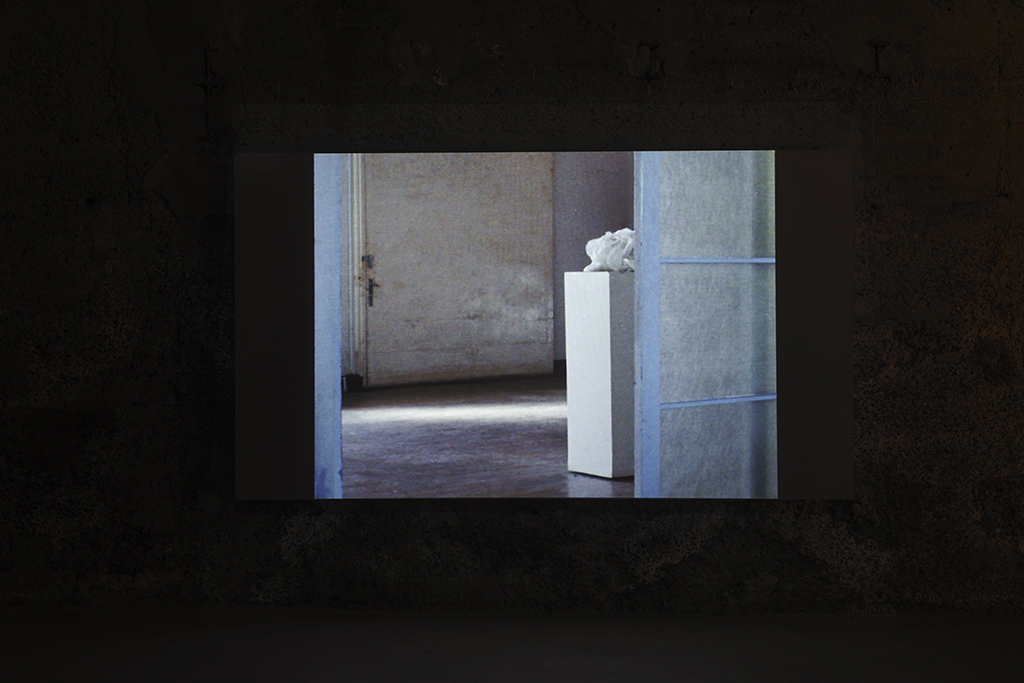It’s supposed to be spooky,” the gallery assistant tells me as he leads me through a maze of tunnels in the dimly-lit basement where I’m told that Charlotte Moth’s film is being screened. For the first time in Montreal, Parisian Laundry is showcasing Charlotte Moth’s “Choreography of the image: Filmic Sketches.” On show until October 8, the exhibit was originally produced in collaboration with the Tate Archive and retells Moth’s story through a series of sketches that display places that are important to Moth in a state of haunting abandonment. In the brief nine minute film, Moth explores the way our experiences are influenced by art, thus impacting how we interact with nature.
Moth explores spaces where human intervention has left them bereft of life. The film begins with closeups of a verdant landscape accompanied by the ambient hum of birds and splash of water, then zooms out into images of brutalistic architecture as intense, orchestral music begins to play. By contrasting two uninhabited settings, Moth explores how emptiness proves tranquil in nature, yet beleaguering and desolate in the city. Moth uses photographic stills to amplify the spectral quality of these buildings, populated by empty chairs and vacant hallways.
Moth explores spaces where human intervention has left them bereft of life.
The only dimension of the film that gave life to these uninhabited spaces was the operatic music. Unlike the natural, diegetic sound that emanated from the previous landscape, the superimposed music was used to obscure the silence that underscores these man-made spaces. Moth exploits the medium of film by editing in sound and contrasting interior and exterior fragments to demonstrate how these edits are necessary to make palatable what we have perverted.
Towards the middle of the film, there is an abrupt scene change accompanied by what sounds like the smoke monster siren sound from Lost. A leafy plant is dramatically staged against a blue, velvet curtain. This scene, heavily choreographed, makes me think of the work as a dance. Instead of bodies defining space, Moth evinces how architecture frames spatial experience, and how the lines between architecture and sculpture are in fact blurry. If we can see dance as living sculpture, bodies presenting and configuring themselves to display the beauty of the human form, monumental architecture can be seen as a choreographer itself, in its mediation and shaping of bodily experience. The film-maker is also a choreographer, in mediating our perception of the architecture that patterns our movements.
Moth also interrogates the potential for art to be deceptive, showing how nature can sometimes elude our desire to capture, imitate, or perfect it through art. The hyperrealistic shots of the plants cast doubt upon whether these are real plants, or spurious replicas – the image appears so real that we suspect it might be false. Is this a documentary image of an augmented reality, or does its augmentation make it completely fake? Of course, our perception is filtered through the reflective medium of film; nothing we see is a first-hand image. The documentary approach with which Moth works focuses on geological features of the land, and their resistance to her desire to confirm the existence of the real, to categorize and typify them, also shows how the natural world elides both our archival and artistic impulses. The faithlessness of art to produce an image of the real is an age-old question that Moth reopens with fresh eyes.
Moth also interrogates the potential for art to be deceptive, showing how nature can sometimes elude our desire to capture, imitate, or perfect it through art.
The minimalist language of the film makes it a pleasure to watch, as viewers are entered into dialogue with the objects presented. However, unlike minimalist sculpture, it is not the viewer who is authoring their own experience of the work. Instead, the experience is mediated by the camera. This enables us to gain insight into the persona of the intermediary, calling to mind avant-garde films that emphasize the voyeuristic gaze of the person behind the lens. We learn about what Moth chooses to zoom into or pan away from, and what details they think are important or irrelevant.
I left the exhibition most curious about the attitudes of the person behind the camera. It was challenging to distinguish whether Moth was trying to convey indifference towards these empty spaces, or if the mood was more confrontational. Moth’s ambivalence urges the viewer to construct meaning for themselves. I consider how up until this point I have seen the author as the arbitrator between the viewer and work. Perhaps in opening up so many questions which can best be answered by looking at the decisions and indecisions of the camera, the work really functions more importantly as a dialogue between the viewer and author.

